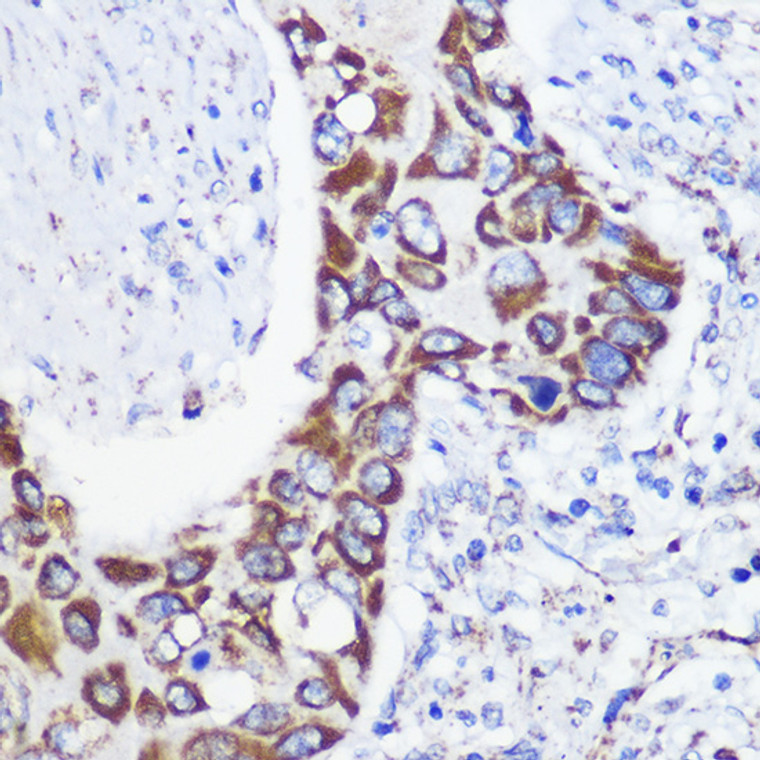| Host: |
Rabbit |
| Applications: |
WB/IHC/IF |
| Reactivity: |
Human/Mouse/Rat |
| Note: |
STRICTLY FOR FURTHER SCIENTIFIC RESEARCH USE ONLY (RUO). MUST NOT TO BE USED IN DIAGNOSTIC OR THERAPEUTIC APPLICATIONS. |
| Short Description: |
Rabbit polyclonal antibody anti-MTMR9 (1-250) is suitable for use in Western Blot, Immunohistochemistry and Immunofluorescence research applications. |
| Clonality: |
Polyclonal |
| Conjugation: |
Unconjugated |
| Isotype: |
IgG |
| Formulation: |
PBS with 0.01% Thimerosal, 50% Glycerol, pH7.3. |
| Purification: |
Affinity purification |
| Dilution Range: |
WB 1:500-1:1000IHC-P 1:50-1:200IF/ICC 1:50-1:200 |
| Storage Instruction: |
Store at-20°C for up to 1 year from the date of receipt, and avoid repeat freeze-thaw cycles. |
| Gene Symbol: |
MTMR9 |
| Gene ID: |
66036 |
| Uniprot ID: |
MTMR9_HUMAN |
| Immunogen Region: |
1-250 |
| Immunogen: |
Recombinant fusion protein containing a sequence corresponding to amino acids 1-250 of human MTMR9 (NP_056273.2). |
| Immunogen Sequence: |
MEFAELIKTPRVDNVVLHRP FYPAVEGTLCLTGHHLILSS RQDNTEELWLLHSNIDAIDK RFVGSLGTIIIKCKDFRIIQ LDIPGMEECLNIASSIEALS TLDSITLMYPFFYRPMFEVI EDGWHSFLPEQEFELYSSAT SEWRLSYVNKEFAVCPSYPP IVTVPKSIDDEALRKVATFR HGGRFPVLSYYHKKNGMVIM RSGQPLTGTNGRRCKEDEKL INATLRAGKRGYIIDTRSL |
| Tissue Specificity | Expressed in many tissues. |
| Function | Acts as an adapter for myotubularin-related phosphatases. Increases lipid phosphatase MTMR6 catalytic activity, specifically towards phosphatidylinositol 3,5-bisphosphate and MTMR6 binding affinity for phosphorylated phosphatidylinositols. Positively regulates lipid phosphatase MTMR7 catalytic activity. Increases MTMR8 catalytic activity towards phosphatidylinositol 3-phosphate. The formation of the MTMR6-MTMR9 complex, stabilizes both MTMR6 and MTMR9 protein levels. Stabilizes MTMR8 protein levels. Plays a role in the late stages of macropinocytosis possibly by regulating MTMR6-mediated dephosphorylation of phosphatidylinositol 3-phosphate in membrane ruffles. Negatively regulates autophagy, in part via its association with MTMR8. Negatively regulates DNA damage-induced apoptosis, in part via its association with MTMR6. Does not bind mono-, di- and tri-phosphorylated phosphatidylinositols, phosphatidic acid and phosphatidylserine. |
| Protein Name | Myotubularin-Related Protein 9Inactive Phosphatidylinositol 3-Phosphatase 9 |
| Database Links | Reactome: R-HSA-1660499Reactome: R-HSA-1660517Reactome: R-HSA-1855183 |
| Cellular Localisation | CytoplasmCell ProjectionRuffle MembranePeripheral Membrane ProteinCytoplasmic SidePerinuclear RegionEndoplasmic ReticulumLocalizes To Ruffles During Egf-Induced MacropinocytosisColocalizes With Mtmr6 To The Perinuclear RegionPartially Localizes To The Endoplasmic Reticulum |
| Alternative Antibody Names | Anti-Myotubularin-Related Protein 9 antibodyAnti-Inactive Phosphatidylinositol 3-Phosphatase 9 antibodyAnti-MTMR9 antibodyAnti-C8orf9 antibodyAnti-MTMR8 antibody |
Information sourced from Uniprot.org
12 months for antibodies. 6 months for ELISA Kits. Please see website T&Cs for further guidance










